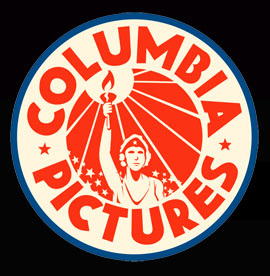


 1939 is considered “Hollywood’s Greatest Year” – and it was a good year for Columbia Pictures. Frank Capra came through with Mr. Smith Goes to Washington. The other parts of the theatrical program were also coming through with a reasonable degree of quality. Charley Chase had come over to the shorts division from Hal Roach. And the cartoons were showing they were doing their research, and continuing to try to capture the high-Warner style of Termite Terrace, though they were also keeping an eye on the folks at the Mouse House, including by producing a celebrity-laden nursery rhyme film discussed below, which was obviously meant to provide competition to one of the recent heavyweight contenders for Oscar consideration – Disney’s Mother Goose Goes Hollywood.
1939 is considered “Hollywood’s Greatest Year” – and it was a good year for Columbia Pictures. Frank Capra came through with Mr. Smith Goes to Washington. The other parts of the theatrical program were also coming through with a reasonable degree of quality. Charley Chase had come over to the shorts division from Hal Roach. And the cartoons were showing they were doing their research, and continuing to try to capture the high-Warner style of Termite Terrace, though they were also keeping an eye on the folks at the Mouse House, including by producing a celebrity-laden nursery rhyme film discussed below, which was obviously meant to provide competition to one of the recent heavyweight contenders for Oscar consideration – Disney’s Mother Goose Goes Hollywood.
Scrappy’s Rodeo (6/2/39) – Scrappy is trying to put on a combination rodeo and wild West show. Margie wants to get involved in it – even dolling up in Redface as an Indian princess. She turns the tables, going on the warpath with bows and arrows, even launching them from the strings of an oversize guitar. Scrappy is pinned to a wall by the arrows, and his shirt tears, leaving him fleeing in embarrassment in his underwear to the sound of Margie’s laughter. Songs: An original entitled “The Western Bad Man”. Plus the oldie “Indianola”, a 1918 WWI song with an American Indian motif, about a chief joining up with the troops to scalp the Kaiser.. Recorded by the American Republic Band for Pathe, the Victor Military Band for Victor, Wilbur C. Sweatman’s Original Jazz Band for Columbia, and the Emerson Military Band on a 7″ Emerson, and with a lyric by Billy Murray for Victor.
Nell’s Yells (6/30/39) – Isn’t it interesting how so many studios were doing spoofs of old time Melodramas. I don’t need to go through a listing of all of them (perhaps it’ll make an appropriate theme for a Wednesday “Animation Trail”?), but there were also songs going around at the time spoofing the same form of entertainment, such as “Little Nell’ by Joe Haymes Orchestra, “No, No, a Thousand Times No”, “The Man On the Flying Trapeze”, and in the early 40’s, “And the Great Big Saw Came Nearer and Nearer”, done by both Spike Jones and the Korn Kobblers. This cartoon manages to catch just about every trope of the genre, including but not limited to the mortgage on the farm, the damsel’s concern about what she and her old deaf father are going to do when they are thrown out into the street, and the villain’s intentions to either get the mortgage payment or take Nell for his wife – whether she wants to or not. Nell’s yells turn out to be supersonic, reaching her hero despite the villain’s claim that they are in a place where no one can hear her. The hero, a chap by the name of Horatio, appears to be entirely clueless as to what to do after he has saved the day. The villain is quite willing to show Horatio with embraces of Nell, thus getting what he wants anyway, and leaving Horatio to utter, “Now, why didn’t I think of that?” Interestingly, the villain neither ties Nell to the railroad tracks, nor sends her on a one-way trip to the buzzsaw. Songs: “The Tooter Ain’t a Tootin’ Anymore”, a parody lyric to one of De Nat’s previous originals, “The Feuders Ain’t A-Feudin Anymore” from The Gorilla Hunt.
Hollywod Sweepstakes (7/28/39) – This is much less of a celebrity caricature cartoon than it is a horse racing cartoon. This was an era when Sea Buscuit was the best known horse on the tracks, and the West Coast was seeing the horse who always seemed to come from behind – “And here comes Malicious”. Horse racing had just come back to California after the 1934 election, when the voters said yes to parimutuel betting. The gags do come at a reasonable clip, essentially about a horse named “Lightning”. Lightning does manage to win the race, and is asked by an animated equivalent of track announcer Clem McCarthy to say a few words to the audience. Lightning obliges with a loud whinny, and iris out. Song: “Santa Lucia”, with a new parody lyric, as “Santa Anita”. This track had only opened a few years before.
Jitterbug Knights (8/11/39) – It’s a day of celebration in the kingdom. The king is about to become a father. The bells are ringing, everybody’s cheering, and the king declares a royal shindig. Three fairies come in for the ball, with their requisite magic wands, wanting to endow the newborn with all that he needs in life. This either give the young prince everything he could ever want, or blunt force trauma. The fairies’ final unison wish is that the prince be a “jitterbug”. At intervals, a hot trumpet is heard from a black herald in the royal band, and some decent swing music rounds out the second half of the film, as the prince shows off his new stuff, and the kingdom dances along. Song: “Our Magic Wands”, an original sung by the Rhythmettes.
The Charm Bracelet (9/1/39) – Scrappy delivers a huge package to Margie’s doorstep as a present and token of his love. The box is a package within a package within a package…etc., boiling down to a final small box containing a charm bracelet, and a romantic card from Scrappy. Margie loves it, and brings it to her bedroom at night, leaving it on her dresser while she sleeps. As she dreams, the charms all come to life, including Father Time beating out a riff on a full drum set, a cuckoo bird in a grandfather’s clock, the three good monkeys (rather different than MGM’s model), a jack in the box, and a small doghouse containing a miniature version of Yippee. The film has no real plot – just instances of the charms not seeming to get along too well with each other, and Yippee getting into mischief. When the alarm clock rings, all the charms race back to their original places on the bracelet, and Margie awakes to kiss her gift before putting it on again. Song: “We’re the Three Wise Monkeys”, an original.
Dreams On Ice (10/20/39) – A young boy decides he wants to go ice skating – so he floods the kitchen with water and opens the window for a wintry breeze, assuming the floor will freeze over so he can skate. (Where is a Zamboni when you need one?) The boy and his dog fall asleep, and dream themselves into an ice carnival, including other dogs (one who serves as “Barker”). However, by the time Mother gets home, all the two awaken to find is a still-flooded room that never froze over. One gets the impression the two will be grounded, without ever getting to skate at all. Song: “A Skating We Will Go”, an original snatch, not set to any hunting melody.
Mother Goose in Swingtime (12/18/39) – Most studios would eventually do cartoons in which Mother Goose was taught to swing. A parody of Baby Snooks and Daddy begin the film. While Daddy is trying to balance the family budget, Snooks keeps bothering him, until he offers to tell her a story if she’ll go straight to bed afterwards. He selects a book of Mother Goose. The girl enters the story in her imagination. The inhabitants of Mother Gosse land are all celebrity caricatures, including Edna Mae Oliver as Mother Goose herself, and others including Martha Rate, Greta Garbo, Jeanette MacDonald and Nelson Eddy, Edward G. Robinson, James Cagney, Katherine Hepburn, Herman Bing, Hugh Herbert, Harry James (with someone quite hot on trumpet on soundtrack – Mannie Klein, perhaps?), Laurel and Hardy, W.C. Fields, the Marx Brothers, Joe E. Brown, Bing Crosby, Jack Benny, Clark Gable, George Raft, Leopold Stokowski, Fred Astaire, Ginger Rogers, Henry Armetta, Wallace Beery, Mickey Rooney, and Ned Sparks, along with several others not as recognizable. No real plot – just a lot of music and familiar faces. Song: “Swing, Cats, Swing”, an original, which gets medleyed-in with a bunch of nursery rhymes.
NEXT TIME: Into a new decade!